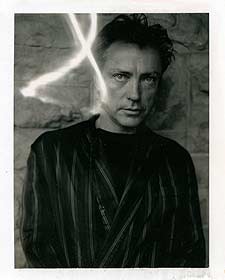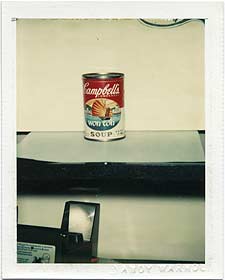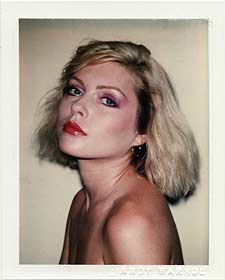



Big Shots at the J-Schnitz
Polaroid portraits by Andy Warhol and Gus Van Sant pop up at JSMA
By Suzi Steffen
Remember Polaroids? The smell of the in-the-film finisher, waving around to dry the snapshot, the immediacy of the physical photo passed around to others?
In the hands of Andy Warhol and Gus Van Sant, the medium became more than instant verification of existence. The two famous and famously fascinated-with-fame men never met, but the Jordan Schnitzer Museum of Art’s Larry Fong, curator of American and regional art, has found a multitude of links between them for “One Step Big Shot: Portraits by Andy Warhol and Gus Van Sant.”
If you’re slightly older than I, you may remember the Big Shot, a device Fong describes as an incredible plastic object. A massive but light Polaroid camera, the Big Shot was produced between 1971 and 1973. The thing’s got a fixed-focus lens, and Fong said that it created what was known as “the Big Shot shuffle” as its wielders tried their hardest to get subjects into focus. Warhol, Fong said, loved the Big Shot, and during sessions with portrait subjects, he’d take between 20 and 200 shots.
But Warhol didn’t want the photos to look closely at the subjects, necessarily. “His aesthetics focused on color,” Fong said, and Warhol shot until he had some he considered perfect for larger screenprinting purposes. He would use make-up powder to flatten the subject’s face and make it more two-dimensional. In the prints, Warhol often used blocks of color to emphasize certain features over others. Polaroids sit next to screened images of the same subjects in the show, but often Fong deliberately picked snapshots that didn’t end up being the direct basis for the larger artwork. “I wanted to show what’s left out and what’s accentuated by the process,” Fong said. In the case of Mick Jagger, the final image doesn’t focus on the many different parts of the singer’s body that Warhol photographed. Instead, it’s his face, with color blocks and other manipulation giving the screenprint an iconic pop feel.
Van Sant used Polaroids for an entirely different purpose, but also in the service of a different, larger form of art. When people read for his movies, especially in his earlier years of filmmaking, Van Sant would simply ask the actor if she would mind his taking a photo after the reading. Then, Fong said, Van Sant often wrote information about the actors — especially those without agents or who weren’t professionals — on the back of the positive. Van Sant used Polaroid 665 film, film which gave him both negatives and positives. “He has preserved the negatives carefully,” Fong said. He kept the positives in little boxes, two of which he loaned to the J-Schnitz for this show.
Van Sant would flip through them, take the positives and pin them on the wall, Fong said, and sometimes put them into certain groups of portraits, which he’d move around and use for casting decisions. Fong said some of the exhibit will show groups of shots from readings for movies like My Own Private Idaho, including a heartbreakingly confident and informal River Phoenix.
Warhol’s Polaroids weren’t exclusively for faces. Candy-colored piles of shoes on two screenprints, with their attendant photos beside them, show more of the artist’s interests, as do the gloriously unflattened prints of male torsos and, as Fong put it, “sex parts.” Those black-and-white images (the torsos have more color) strongly suggest Warhol’s abilities as an artist, with their clear connection to the long history of artists creating erotic, or at the least sexual, images. The Polaroids are vividly fleshy, but the prints of penises, balls and anuses are starkly gorgeous. “He chose to accentuate with black line,” Fong said. “Even though you know what the subject is, they become more abstract in comparison to the source Polaroid.”
Fong came up with the exhibition idea after the Warhol Foundation donated a number of images to the JSMA. “I thought it was a brilliant way to make Andy Warhol’s images fresh, to give them new life,” said Jill Hartz, the museum’s executive director. “You can always do a Warhol show, but this is something different.”
In addition to the prints and Polaroids, the show contains and will loop two of Warhol’s short films and three of Van Sant’s.
The free opening, with music from Portland band The Hugs, food and no-host bar, runs from 6-9 pm Saturday, May 15, at the Jordan Schnitzer Museum of Art. To RSVP to the event, go to the museum’s Facebook page at http://wkly.ws/jq and find more info at http://jsma.uoregon.edu or 541-346-3027.



Top row: Debra Messing; Keanu Reeves; Patricia Clarkson, all by and © Gus Van Sant. Bottom row: Udo Kier, by and © Gus Van Sant Campbell’s Soup Can (Won Ton Soup); Debbie Harry, both by Andy Warhol and © The Andy Warhol Foundation for the Visual Arts